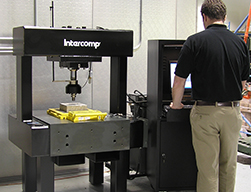 Upon completion of nearly two years of testing and validation, the U. S. Air Force has granted Intercomp first article approval to begin shipping automated force calibration systems to its Precision Measurement Equipment Laboratories (PMEL). In all, eleven systems will be delivered to PMELs around the world for verification and adjustment of portable truck scales, aircraft scales, and general purpose platform scales. Bases include Edwards, Ramstein, and Al-Udeid.
Upon completion of nearly two years of testing and validation, the U. S. Air Force has granted Intercomp first article approval to begin shipping automated force calibration systems to its Precision Measurement Equipment Laboratories (PMEL). In all, eleven systems will be delivered to PMELs around the world for verification and adjustment of portable truck scales, aircraft scales, and general purpose platform scales. Bases include Edwards, Ramstein, and Al-Udeid.
Intercomp’s automated force press provides complete hands-free operation during scale calibration. The press utilizes a communication capability that will automatically calibrate and adjust the scales by pressing one button. The company says the engineered stability maintains 0.02 lbs of force for the 5,000 lb range to 0.2 lbs of force for the 60,000 lb range. Integrating precision Tovey load cells into the system, Intercomp say sit provides an accuracy of ±0.025 percent or better to maintain a 4:1 ratio when calibrating scales to 0.1 percent of applied load.
“Many of the scales that PMEL calibrates on these presses are used for critical weight and balance checks of aircraft or the load planning of cargo shipped by air, sea or rail for rapid deployment purposes,” according to Eric Peterson, Intercomp vice president of Sales and Marketing. “These next generation calibration systems provide PMELs the ability to quickly validate accuracy of scales to ensure our military readiness in the aircraft and cargo they must weigh.”
Intercomp also developed new calibration press software to align press operations with the specific process needs of the Air Force. The updated software streamlines data flow to facilitate recall calibration and scale history while enhancing tracking and maintenance throughout a scale’s lifecycle. The 60,000 lb, automated, hydraulic presses expedite the calibration process, while reducing technician interface requirements.
Intercomp’s fully automated or manual test stands are available in capacities to 100,000 lbs (50,000 kgs) with an accuracy of ±0.025 percent, and maintain first echelon certification directly traceable to the National Institute of Standards and Technology (NIST).